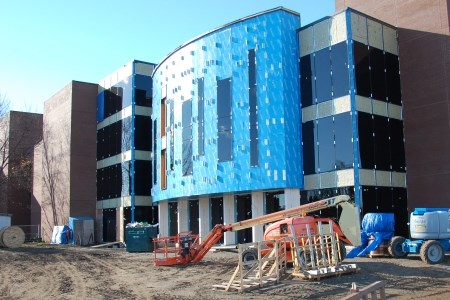Tough economic times remain in northwestern Ontario, but construction activity in Thunder Bay was healthy in 2010.
A tight resale market for homes sparked a surge in home building, said Canada Mortgage and Housing Corporation (CMHC).
After a busy six consecutive months, new construction tailed off in November with only 10 single- etached homes breaking ground.
Still, the city has done well with 191 singles built through 11 months of 2010, up nearly 21 per cent from last year’s mark of 158. The volume of starts of semi-detached and multi-residential units was slightly ahead of the 2009 pace by four units.
Coming out of a recession, CMHC’s Northern Ontario Market Analyst Warren Philp said Thunder Bay has exhibited a “strong, balanced market” in new home construction and resale activity.
Some choice subdivisions, near the airport and in the corridor between Lakehead University and the new hospital, have sold well.
During 2009, Thunder Bay was not spared from the nationwide impact of the recession on the home resale side. The market is down 14 per cent from the previous year. But things got off to a rocket start in early 2010 with the first quarter up 30 per cent over the previous year.
“The first four months were crazy busy in Thunder Bay like in most parts of the country in the resale market,” before cooling off during the middle months, said Philp. Heading into the fall, overall sales for 2010 were up only four per cent.
The early home-buying frenzy was spurred by the threat of increased interest rates, the introduction of the Harmonized Sales Tax and an early spring.
CMHC’s third-quarter stats actually showed sales were down 12 per cent compared to 2009 but strangely enough, prices were up 10 per cent.
Philp said much of that has to do with a simple “supply and demand” issue in affordably priced homes.
There remains a chronic shortage of local listings of homes in $150,000 to $280,000 range in Thunder Bay.
Philp attributes much of that crunch to aging homeowners who are staying put, and displaced forestry workers who kept their homes but began commuting to distant jobs. What’s become prevalent is home bidding wars that resulted in about 20 per cent of Thunder Bay homes selling over list price.
But the fact that Thunder Bay did well during the hangover from the economic recession bodes well for the future.
Philp said there are signs that the city’s diversification efforts are starting to bear fruit. Statistics Canada migration numbers show an inflow of 92 people in 2008-2009, the first time in six years.
Philp attributes that partly to the new knowledge economy, but also from people migrating from outlying areas to retire and find work.
In other sectors of construction, Thunder Bay’s project pipeline is looking robust.
Heading in November, the City of Thunder Bay posted $143 million in the construction value of permits, way ahead of the $64 million posted in 2009, and close to the all-time record of $175 million recorded in 2002.
Much of it was invested on the institutional, commercial and multi-residential side, said Des Stolz, the City of Thunder Bay’s deputy chief building official.
Confederation College is grafting a $13 million expansion onto its main Shuniah Building which will be the home of the school of community health.
Lakehead University’s Braun building is undergoing a $3.6-million renovation after fire gutted the place in 2008.
St. Joseph’s Care Group has taken out a permit for construction of a $60-million long-term care bed and seniors housing complex as part of its Centre of Excellence for Integrated Seniors’ Services project.
The city’s south end is getting special attention.
The former McKellar hospital has been transformed into a 100-unit retirement living complex by Habib Enterprises.
Nearby, Habib intends to convert the former Fort William Collegiate into a 60-unit seniors complex, a plan that could go forward this year.
A $12-million, 94-unit seniors retirement home is being built on Isabella Street in the south end, while an $11.6-million district social services administration building is underway on Brodie Street.
In the north end, as part of the multi-phase Prince Arthur’s Landing development, a waterfront pavilion is being built along with an addition onto a former CPR baggage house near the historic passenger station. Expansion of the marina is set to start along with the groundbreaking for a boutique hotel and two condominiums.
On the retail side, Leon’s is finishing off a new 75,000-square-foot furniture store, and Wal-Mart completed a $5-million expansion.
Stolz said 2011 is shaping up to be an even better year with the groundbreaking for a new provincial courthouse in the south end downtown core. The $473-million contract was awarded to a construction consortium of Plenary Justice to design, build, finance and maintain the building for the next 30 years.
“Certainly it will be the landmark building in the South Ward when it’s done.”
There’s also a slew of condominium complexes on the books including Westcan Development of Winnipeg’s plans for an eight-storey south-end retirement residence known as Compass Square, and local realtor Robert Zanette is the selected developer of a condo complex at the Thunder Bay Golf and Country Club.
www.cmhc.ca
www.thunderbay.ca




